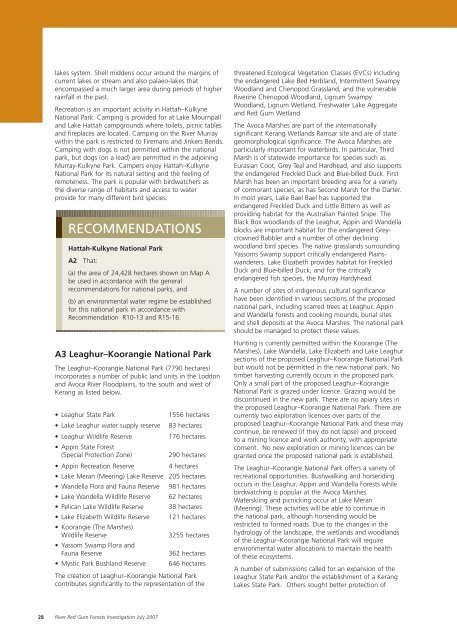Draft Proposals Paper - Full - Victorian Environmental Assessment ...
Draft Proposals Paper - Full - Victorian Environmental Assessment ...
Draft Proposals Paper - Full - Victorian Environmental Assessment ...
You also want an ePaper? Increase the reach of your titles
YUMPU automatically turns print PDFs into web optimized ePapers that Google loves.
lakes system. Shell middens occur around the margins of<br />
current lakes or stream and also palaeo-lakes that<br />
encompassed a much larger area during periods of higher<br />
rainfall in the past.<br />
Recreation is an important activity in Hattah–Kulkyne<br />
National Park. Camping is provided for at Lake Mournpall<br />
and Lake Hattah campgrounds where toilets, picnic tables<br />
and fireplaces are located. Camping on the River Murray<br />
within the park is restricted to Firemans and Jinkers Bends.<br />
Camping with dogs is not permitted within the national<br />
park, but dogs (on a lead) are permitted in the adjoining<br />
Murray-Kulkyne Park. Campers enjoy Hattah–Kulkyne<br />
National Park for its natural setting and the feeling of<br />
remoteness. The park is popular with birdwatchers as<br />
the diverse range of habitats and access to water<br />
provide for many different bird species.<br />
RECOMMENDATIONS<br />
Hattah-Kulkyne National Park<br />
A2<br />
That:<br />
(a) the area of 24,428 hectares shown on Map A<br />
be used in accordance with the general<br />
recommendations for national parks, and<br />
(b) an environmental water regime be established<br />
for this national park in accordance with<br />
Recommendation R10-13 and R15-16.<br />
A3 Leaghur–Koorangie National Park<br />
The Leaghur–Koorangie National Park (7790 hectares)<br />
incorporates a number of public land units in the Loddon<br />
and Avoca River Floodplains, to the south and west of<br />
Kerang as listed below.<br />
• Leaghur State Park<br />
• Lake Leaghur water supply reserve<br />
• Leaghur Wildlife Reserve<br />
• Appin State Forest<br />
(Special Protection Zone)<br />
• Appin Recreation Reserve<br />
1556 hectares<br />
83 hectares<br />
176 hectares<br />
290 hectares<br />
4 hectares<br />
• Lake Meran (Meering) Lake Reserve 205 hectares<br />
• Wandella Flora and Fauna Reserve<br />
• Lake Wandella Wildlife Reserve<br />
• Pelican Lake Wildlife Reserve<br />
• Lake Elizabeth Wildlife Reserve<br />
• Koorangie (The Marshes)<br />
Wildlife Reserve<br />
• Yassom Swamp Flora and<br />
Fauna Reserve<br />
• Mystic Park Bushland Reserve<br />
981 hectares<br />
62 hectares<br />
38 hectares<br />
121 hectares<br />
3255 hectares<br />
362 hectares<br />
646 hectares<br />
The creation of Leaghur–Koorangie National Park<br />
contributes significantly to the representation of the<br />
threatened Ecological Vegetation Classes (EVCs) including<br />
the endangered Lake Bed Herbland, Intermittent Swampy<br />
Woodland and Chenopod Grassland, and the vulnerable<br />
Riverine Chenopod Woodland, Lignum Swampy<br />
Woodland, Lignum Wetland, Freshwater Lake Aggregate<br />
and Red Gum Wetland.<br />
The Avoca Marshes are part of the internationally<br />
significant Kerang Wetlands Ramsar site and are of state<br />
geomorphological significance. The Avoca Marshes are<br />
particularly important for waterbirds. In particular, Third<br />
Marsh is of statewide importance for species such as<br />
Eurasian Coot, Grey Teal and Hardhead, and also supports<br />
the endangered Freckled Duck and Blue-billed Duck. First<br />
Marsh has been an important breeding area for a variety<br />
of cormorant species, as has Second Marsh for the Darter.<br />
In most years, Lake Bael Bael has supported the<br />
endangered Freckled Duck and Little Bittern as well as<br />
providing habitat for the Australian Painted Snipe. The<br />
Black Box woodlands of the Leaghur, Appin and Wandella<br />
blocks are important habitat for the endangered Greycrowned<br />
Babbler and a number of other declining<br />
woodland bird species. The native grasslands surrounding<br />
Yassoms Swamp support critically endangered Plainswanderers.<br />
Lake Elizabeth provides habitat for Freckled<br />
Duck and Blue-billed Duck, and for the critically<br />
endangered fish species, the Murray Hardyhead.<br />
A number of sites of indigenous cultural significance<br />
have been identified in various sections of the proposed<br />
national park, including scarred trees at Leaghur, Appin<br />
and Wandella forests and cooking mounds, burial sites<br />
and shell deposits at the Avoca Marshes. The national park<br />
should be managed to protect these values.<br />
Hunting is currently permitted within the Koorangie (The<br />
Marshes), Lake Wandella, Lake Elizabeth and Lake Leaghur<br />
sections of the proposed Leaghur–Koorangie National Park<br />
but would not be permitted in the new national park. No<br />
timber harvesting currently occurs in the proposed park.<br />
Only a small part of the proposed Leaghur–Koorangie<br />
National Park is grazed under licence. Grazing would be<br />
discontinued in the new park. There are no apiary sites in<br />
the proposed Leaghur–Koorangie National Park. There are<br />
currently two exploration licences over parts of the<br />
proposed Leaghur–Koorangie National Park and these may<br />
continue, be renewed (if they do not lapse) and proceed<br />
to a mining licence and work authority, with appropriate<br />
consent. No new exploration or mining licences can be<br />
granted once the proposed national park is established.<br />
The Leaghur–Koorangie National Park offers a variety of<br />
recreational opportunities. Bushwalking and horseriding<br />
occurs in the Leaghur, Appin and Wandella Forests while<br />
birdwatching is popular at the Avoca Marshes.<br />
Waterskiing and picnicking occur at Lake Meran<br />
(Meering). These activities will be able to continue in<br />
the national park, although horseriding would be<br />
restricted to formed roads. Due to the changes in the<br />
hydrology of the landscape, the wetlands and woodlands<br />
of the Leaghur–Koorangie National Park will require<br />
environmental water allocations to maintain the health<br />
of these ecosystems.<br />
A number of submissions called for an expansion of the<br />
Leaghur State Park and/or the establishment of a Kerang<br />
Lakes State Park. Others sought better protection of<br />
28 River Red Gum Forests Investigation July 2007
















